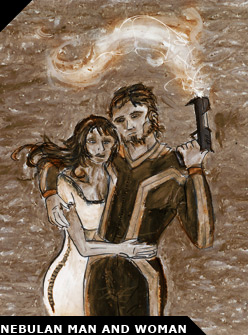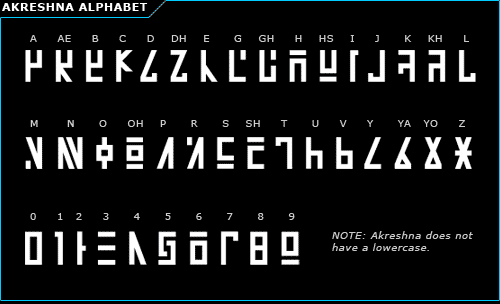HOMEWORLD: NEBULUS
The Nebulan race has a rich history, so much so that it is difficult to separate the reality from fantasy. Nebulans believe they are descended from nomadic conquerors. Most scientists believe that a race similar to one described by Nebulans – and dozens of other species – did exist, and swept through civilized space not long after the foundation of the Terra Nova Empire. They are known in historical theory as the Kresh. However, Nebulan claims to the Kresh bloodline are thin at best, and evidence exists for human activity on Nebulus before the Kresh are believed to have come.
 Modern Nebulans differ little from their pre-empire ancestors. They are generally tall and muscular, with faces often described as “carved” and brightly colored eyes. Their hair color tends toward black, and their skin tone toward tan. Beards play an important role in the male side of society, as do hairstyles. The older and more experienced a male becomes, the longer he is permitted to grow his hair and beard. As they grow, the hair is braided into tight locks – giving them a sometimes frightening appearance to enemies. The emphasis on beards as a distinguishing feature is credited to Akkeans, who have had regular contact and trade with the Nebulan Empire for millennia. Yet their most notorious feature is physical prowess, as they are stronger than other humanoids save Akkeans and have nearly as high a pain tolerance. As such, they are formidable soldiers, even when advanced in years. Average Nebulan life expectancy is around 150 years, though usually less for the males and females who swell the army.
Modern Nebulans differ little from their pre-empire ancestors. They are generally tall and muscular, with faces often described as “carved” and brightly colored eyes. Their hair color tends toward black, and their skin tone toward tan. Beards play an important role in the male side of society, as do hairstyles. The older and more experienced a male becomes, the longer he is permitted to grow his hair and beard. As they grow, the hair is braided into tight locks – giving them a sometimes frightening appearance to enemies. The emphasis on beards as a distinguishing feature is credited to Akkeans, who have had regular contact and trade with the Nebulan Empire for millennia. Yet their most notorious feature is physical prowess, as they are stronger than other humanoids save Akkeans and have nearly as high a pain tolerance. As such, they are formidable soldiers, even when advanced in years. Average Nebulan life expectancy is around 150 years, though usually less for the males and females who swell the army.
Nebulan society impressed the Akkeans of ages past for one simple reason: warfare is the core of their purpose in life. Their virtues are strength, loyalty, courage, humility, and discipline. Men are trained from the age of seven as an elite warrior class, a process that is brutal and often lethal. Slight disobedience can easily be countered with a plasma bolt between the eyes. Ten years after their age of ascension (sixteen standard years), Nebulan males are permitted to expand their horizons into tactical school and promotion to officer status or other military-related ventures. Women are also able to serve as Szlekena. Their training is easily as rigorous, but women are never allowed to serve in the core of the Imperial Army. More often, women serve as a major percentage of the Nebulan government, merchant class, Navy, and are highly valued for being the bearers of future generations of warriors.
Beneath the cruelty of their military existence, the Nebulans have a deep-seated spiritual philosophy they adhere to. Nebulan beliefs are based around the concept of a Cycle of Order that is both time and space. It spirals ever onward, and seeks a balance in the universe. To disturb places of the past (such as battlefields and graveyards), unnecessarily destroy ecosystems, or have an excess of souls in the society or galaxy, is to unbalance the Cycle and bring backlash. To help aid the Cycle, Nebulans practice Exposure, whereby newborns are examined for deformities or crippling ailments. Any such infirm children are believed to be the result of an excess in souls and are cast into designated ravines, to their deaths. This particular practice is considered the most odious to outsiders, particularly Terrans. This core belief system permeates throughout Nebulan society, dictating very thoroughly the successes or failures of the Empire in the minds of the people. However, some Nebulan elites have since disregarded belief in the Cycle of Order, causing internal unrest amongst the ruling Ghozakna.

Akreshna, meaning roughly “the Kresh,” is the official language of the Nebulan Star Empire, and the primary language of ethnic Nebulans. The roots of Akreshna lay in the distant past with the unified Nebulan people, before their interstellar expansion. It is often considered coarse and difficult for speakers of Common Elurian to enunciate. Most of the words are believed to be original, but some sounds and its alphabet are definitively influenced by other sources. Akkea is acknowledged for the style of writing and some phonetic values. Elurian is the basis of Akreshna syntax, though with heavy modification for simplicity and consistency. Some phonetic values are clearly foreign, but their source is unknown. Nebulan historians often cite a people called the Myninsona for these anomalies – some of which appear in Elurian and other major languages. (Curiously, the Akreshna word mininsvo, a derivative of Myninsona, means “beautiful.” Some Nebulan scholars believe the Myninsona language itself was considered beautiful by the ancient Nebulans.)
![]()

